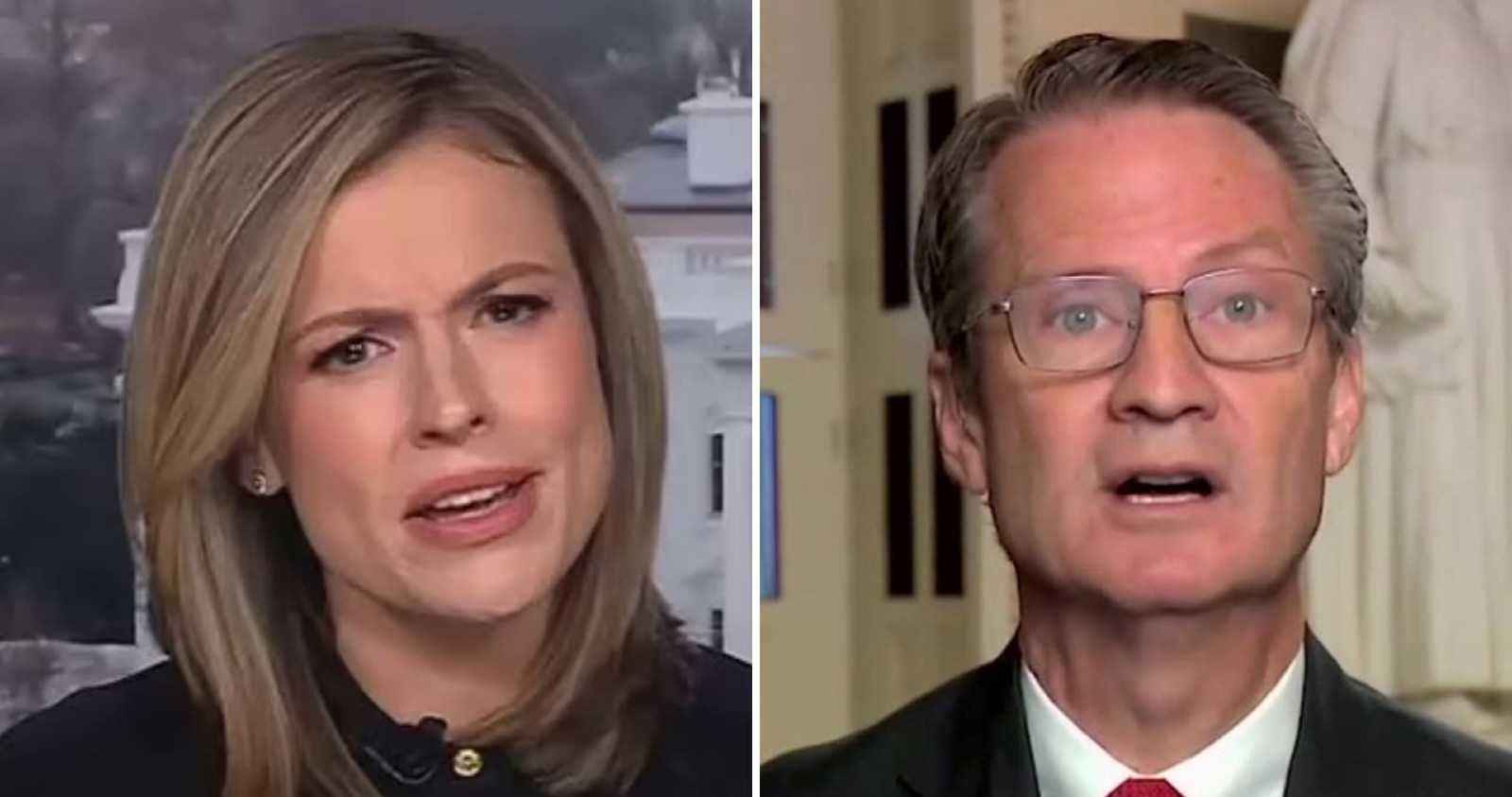In a televised segment on Tuesday, an exchange unfolded between Rep. Tim Burchett (R-Tenn.) and CNN host Pamela Brown during a discussion about President Trump’s administration efforts to address what it terms “government waste.” The discussion was sparked by recent initiatives designed to streamline federal spending amid a national debt exceeding $36 trillion. These efforts, which include a proposal led by Trump to implement significant cuts to government programs and reduce the number of employees in federal agencies, have stirred vigorous debate among lawmakers, commentators, and the broader public.
During the live broadcast, the debate quickly became contentious. Rep. Burchett, a vocal proponent of the administration’s cost-cutting measures, directly challenged host Brown’s assertions regarding the effectiveness and methodology of these reforms. The congressman argued that Brown’s criticisms were not only unfounded but also indicative of a broader media bias. In response, Brown maintained that the administration’s approach was “clumsy rather than methodical” and raised concerns about the potential adverse impacts of the proposed cuts on critical government functions.
This article provides a thorough account of that on-air debate, delving into the key issues raised by both parties, analyzing the broader political and regulatory context, and examining the implications of the exchange for discussions on government efficiency, public accountability, and media framing in a polarized political climate.
Background and Context: Trump’s Initiative to Reduce Government Waste
The Fiscal Challenge Facing the United States
The United States currently faces a daunting fiscal challenge with a national debt that has soared beyond $36 trillion. Against this backdrop, the Trump administration has placed renewed emphasis on reducing federal spending and eliminating what it deems to be unnecessary bureaucracy. Central to these efforts is the concept of “government efficiency”—a drive to streamline operations, eliminate redundant programs, and cut down on what critics call “bloated programs” that contribute to fiscal waste.
The Administration’s Approach: Cost-Cutting and Streamlining
At the core of President Trump’s strategy is a series of proposals aimed at transforming the operational landscape of federal agencies. These proposals include:
- Reducing Workforce Size: Advocates argue that trimming the number of employees—particularly in non-essential positions—will result in a leaner, more agile bureaucracy. Critics, however, caution that excessive cuts could erode the capacity for oversight and service delivery.
- Merit-Based Hiring: The administration has emphasized the importance of hiring and retaining the best and the brightest. By shifting focus toward competence and efficiency, it aims to ensure that public safety and critical services are maintained even as overall headcounts are reduced.
- Enhanced Accountability: Proponents contend that increased accountability measures will force agencies to justify their spending and operations, thereby eliminating inefficiencies and reducing taxpayer waste.
These proposals have been met with mixed reactions. While some view the initiative as a necessary step toward fiscal responsibility, others see it as an overly aggressive attempt to cut costs without adequately considering the potential impact on public services.
Media Coverage and Public Discourse
The initiative has generated significant media coverage and public debate. Various news outlets have dissected the potential ramifications of a leaner federal workforce, with analysts debating whether the proposed measures will indeed lead to greater efficiency or if they risk undermining the critical functions of federal agencies. Amid this debate, discussions have also emerged around the role of technology and innovation in modernizing government operations, with some arguing that investments in digital transformation may offer an alternative path to increased efficiency without the collateral damage of widespread layoffs.
The On-Air Exchange: A Detailed Account of the Debate
Setting the Stage: The Discussion on Government Waste
The on-air debate occurred during a live broadcast on Tuesday, when CNN host Pamela Brown opened the segment by questioning the methodology behind the Trump administration’s efforts to curtail government waste. Brown’s line of inquiry was focused on whether the administration’s approach was truly methodical or if it amounted to a series of “high-stakes mistakes” that could compromise the delivery of essential government services.
During the discussion, Brown expressed concerns that recent policy decisions—particularly those related to reducing the number of government employees—could have unintended consequences. She argued that such measures might lead to operational disruptions, citing specific examples of programs where workforce reductions had already led to logistical challenges. Her comments were framed within a broader narrative of caution: that while efficiency is important, it must not come at the expense of public accountability and safety.
The Republican Response: Rep. Tim Burchett’s Rebuttal
Representative Tim Burchett, known for his forthright criticism of what he views as inefficiencies in government spending, responded with a series of pointed remarks that escalated the debate. Burchett took issue with Brown’s implied criticism of the administration’s efforts, contending that the measures in question were necessary to tackle the persistent problem of government waste. He argued that the administration’s approach was evidence-based and designed to eliminate redundancies that have long plagued federal agencies.
In his remarks, Burchett highlighted several key points:
- Defense of Workforce Reductions: Burchett maintained that the proposed reductions in workforce were justified. He referenced what he described as “no-show employees” and individuals whose roles had become redundant or misaligned with modern operational needs. According to Burchett, these workforce reductions were not arbitrary but were part of a systematic effort to realign federal resources with current priorities.
- Criticism of Media Bias: In a particularly forceful moment, Burchett directly addressed the host, asserting that her network’s repeated criticism of the Trump administration’s initiatives was indicative of a broader media bias. “All y’all do is run down Elon Musk and Donald Trump, and you continuously do this. And that’s why your ratings are in the tank, ma’am,” he stated. This remark underscored his view that the media’s focus on negativity was not only unfair but also detrimental to public discourse.
- Emphasis on Accountability and Reform: Burchett argued that the proposed measures were part of a necessary reform process. He posited that by streamlining operations and focusing on merit-based hiring, the government could better manage its spending and improve overall efficiency. In his view, the questions raised by Brown were less about the validity of the reforms and more about the media’s tendency to attack the messenger rather than engage with the substance of the policy.
The Exchange of Perspectives: Points of Contention
During the debate, the conversation quickly shifted from general observations about government waste to more specific issues related to the role of oversight and accountability in federal agencies. Pamela Brown raised several pointed questions, including:
- The Role of Unelected Officials: Brown questioned the extent to which unelected individuals, particularly those with access to sensitive government information, should be allowed to influence operational decisions. She argued that there were “fair questions” to be asked about the potential risks associated with such practices.
- Concerns About Regulatory Oversight: Brown also highlighted the need for greater transparency in how federal agencies manage their operations. She pointed out that, in her view, the administration’s efforts to reduce costs must be balanced with the imperative of maintaining robust oversight, especially in areas related to public safety.
- Public Accountability and Safety: At the heart of Brown’s argument was the concern that cost-cutting measures should not compromise the quality of services provided to the American people. She contended that while efficiency is important, it must be pursued in a manner that does not jeopardize the accountability or effectiveness of government agencies.
Rep. Burchett, for his part, argued that these concerns were secondary to the urgent need to address long-standing inefficiencies. He maintained that the current bureaucratic system had become too large and unresponsive, and that the proposed reforms were a necessary corrective measure. His responses were characterized by a combative tone, suggesting that the criticisms from the media were an attempt to deflect attention from the benefits of a leaner, more efficient government.
The Dynamics of Live On-Air Debate
The live nature of the exchange added an element of immediacy and intensity to the discussion. With both sides articulating their positions in real time, the debate reflected the broader political polarization that has come to define contemporary media discourse. On one hand, there was a clear sense of frustration from the Republican side, represented by Burchett’s forceful rebuttals and pointed criticisms of media practices. On the other hand, the CNN host’s insistence on scrutinizing the practical implications of government reforms underscored the ongoing debate over how best to balance fiscal responsibility with public service.
The heated back-and-forth not only captured the attention of viewers but also served as a microcosm of the larger political battles currently underway. Issues such as government efficiency, media bias, and regulatory oversight are not confined to any single debate; rather, they represent ongoing points of contention that continue to shape public policy and political discourse across the country.
<blockquote class=”twitter-tweet” data-media-max-width=”560″><p lang=”en” dir=”ltr”> 911, I need to report the m*rder of CNN.<br><br>HOST: No one is disagreeing there is government bloat/waste, CNN has been covering it.<br><br>TIM BURCHETT: No you haven't. All y'all do is run down Musk and Trump, and that's why your ratings are in the tank.<a href=”https://t.co/RCGrhKzzVM”>pic.twitter.com/RCGrhKzzVM</a></p>— Eric Daugherty (@EricLDaugh) <a href=”https://twitter.com/EricLDaugh/status/1891884301643333872?ref_src=twsrc%5Etfw”>February 18, 2025</a></blockquote> <script async src=”https://platform.twitter.com/widgets.js” charset=”utf-8″></script>

Lila Hart is a dedicated Digital Archivist and Research Specialist with a keen eye for preserving and curating meaningful content. At TheArchivists, she specializes in organizing and managing digital archives, ensuring that valuable stories and historical moments are accessible for generations to come.
Lila earned her degree in History and Archival Studies from the University of Edinburgh, where she cultivated her passion for documenting the past and preserving cultural heritage. Her expertise lies in combining traditional archival techniques with modern digital tools, allowing her to create comprehensive and engaging collections that resonate with audiences worldwide.
At TheArchivists, Lila is known for her meticulous attention to detail and her ability to uncover hidden gems within extensive archives. Her work is praised for its depth, authenticity, and contribution to the preservation of knowledge in the digital age.
Driven by a commitment to preserving stories that matter, Lila is passionate about exploring the intersection of history and technology. Her goal is to ensure that every piece of content she handles reflects the richness of human experiences and remains a source of inspiration for years to come.
